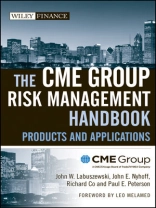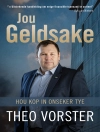Praise for The CME Group Risk Management Handbook
‘Wow! The CME Group Risk Management Handbook is a ‘ten
strike’ and long overdue. A must-read and reference for the risk
management industry!’
—Jack Sandner, retired chairman of CME Group, member
of the Executive Committee
‘This is a powerful book for its integration of futures and
options markets with an understanding of the whole economy. It is
an eye-opener to see how central these markets are to our economic
lives.’
—Robert J. Shiller, Okun Professor of Economics, Yale
University; Chief Economist, Macro Markets LLC
‘Risk management is essential to successful investing, and
The CME Group Risk Management Handbook provides the
essentials for understanding risk management. In the wake of the
financial turmoil of the last few years, managing risk should be
part of any investment program. Among the key elements of risk
management are stock index, bond, currency, and commodity futures
as well as a growing number of futures, options, swaps, and other
financial instruments built on indices tracking housing prices,
weather conditions, and the economy. The CME Group Risk
Management Handbook offers a comprehensive guide for using all
of these to better manage financial risks.’
—David M. Blitzer, Ph D, Managing Director and
Chairman of the Index Committee, S&P Indices
‘Dare we ignore the advice of a financial institution, the
largest of its kind in the world, that navigated the recent
financial crisis without the aid of a single TARP dollar or access
to the Fed’s cheap loans? For CME Group, risk management has meant
risk minimization as it enters its 151st year of life and its 85th
year of central counterparty clearing without a single trading debt
unpaid. It has been, and continues to be, a leader by
example.’
—Philip Mc Bride Johnson, former CFTC chairman
‘For the first time, a comprehensive handbook outlining the
futures market in today’s world is available. The CME Group Risk
Management Handbook covers futures basics for the novice
trader, while the veterans will benefit from an in-depth look at
options and hedging. This handbook is a necessity for any
professional, investor, or other market participant seeking to
manage risk in the perpetually changing futures market.’
—H. Jack Bouroudjian, CEO, Index Futures Group
Содержание
Foreword by Leo Melamed.
Prologue by Terry Duffy.
Acknowledgments.
Introduction by Craig S. Donohue.
Chapter 1 Futures Market Fundamentals.
What Is a Futures Contract?
Overview of Popular Financial Futures Contracts.
Anatomy of a Futures Transaction.
Conclusion.
Notes.
Chapter 2 Order Entry and Execution Methodologies.
Open Outcry or Pit Trading.
Introduction of the CME Globex Platform.
Trade Matching Algorithms.
About Options Markets.
Ex-Pit Trading.
Conclusion.
Notes.
Chapter 3 Role of the Clearinghouse.
Financial Safeguards.
Financial Surveillance.
Default by a Clearing Member.
Resources Backing CME Group Clearing System.
Customer Protection.
Disaster Recovery and Business Continuity.
Rule Enforcement.
Financial and Regulatory Information Sharing.
Conclusion.
Chapter 4 Currency Futures: The First Financial Futures.
Evolution of Foreign Exchange Marketplace.
Over-the-Counter Currency Trading Vehicles.
Exchange-Traded Currency Futures and Options.
Foreign Exchange Market Growth and Trends.
Conclusion.
Notes.
Chapter 5 Stock Index Futures: The First Financial Futures.
Mechanics of Stock Index Futures.
E-Minis versus Exchange-Traded-Funds.
Pricing Stock Index Futures.
Spreading Stock Index Futures.
Hedging with Stock Index Futures.
Portable Alpha Strategies.
Conclusion.
Notes.
Chapter 6 Eurodollar Futures: Interest Rate Market Building Blocks.
Eurodollar Futures Market.
Speculating on Shape of Yield Curve.
Term Treasury/Eurodollar (TED) Spreads with Futures and Options.
Interest Rate Swap Market.
Growing Up Together.
Pricing Relationship.
Hedging Techniques.
Conclusion.
Technical Appendix: Complications and Shortcuts for Pricing and Hedging Swaps.
Notes.
Chapter 7 Understanding U.S. Treasury Futures.
Coupon-Bearing Treasury Securities.
Treasury Futures Delivery Practices.
Measuring Risk of Coupon-Bearing Securities.
Risk Management with Treasury Futures.
Macro Hedging with Treasury Futures.
Trading the Yield Curve with Treasury Futures.
Conclusion.
Notes.
Chapter 8 Commodities: Backbone of the Futures Industry.
What Are Commodities?
Grain Markets.
Livestock Markets.
Energy Products.
Precious Metals.
The Forward Curve.
Intermarket Commodity Spreading.
Clear Port Over-the-Counter Clearing Facility.
Conclusion.
Appendix: Major Commodity Market Specifications.
Chapter 9 Alternative Investment Market fundamentals.
Weather.
Residential Housing Futures.
Economic Indicators.
Conclusion.
Notes.
Chapter 10 Fundamental Market Indicators.
Why These Indicators?
Trading Volumes.
Volatility: Daily Net Change.
Volitility: Daily High-Low Range.
Conclusions.
Appendix: Economic Indicator Descriptions.
Notes.
Chapter 11 Technical Analysis Primer.
Why Technical Analysis?
Interpreting Charts.
Elliot Wave Theory.
Intraday Trading Techniques.
Trend-Following Systems.
Conclusion.
Chapter 12 Fundamentals of Option Markets.
What is an Option?
Mathematical Option Pricing Models.
Historic and Implied Volatilities.
Measuring Option Performance.
Conclusion.
Chapter 13 Option Trading Strategies.
Option Spreads.
Horizontal Spreads.
Diagonal Spreads.
Comparing Verticals, Horizontals, and Diagonals.
Weighted Spreads.
Volatility-Driven Strategies.
Specialty Option Strategies.
Matching Strategy and Forecast.
Conclusion.
Chapter 14 Hedging with Options.
Baseline Futures Hedge.
Buying Protection with Puts.
Yield Enhancement with Calls.
In- and Out-of-the-Money Options.
Matching Strategy with Forecast.
Collar Strategy.
Delta-Neutral Hedge.
Conclusion.
About the Authors and Contributors.
Index.
Об авторе
JOHN W. LABUSZEWSKI is Managing Director of Research and
Product Development at CME Group. Labuszewski came to CME from
Nikko Securities International, where he was general manager of the
asset management division. He had previously worked for Fenchurch
Capital Management, Refco, and the Chicago Board of Trade.
Labuszewski is coauthor of four previous industry-related texts. He
earned an MBA from the University of Illinois.
JOHN E. NYHOFF is Director of Financial Research and
Product Development at CME Group. He has lectured extensively in
the interest rate derivative product area, and has taught financial
futures and options and related courses at De Paul University and
several other Chicago-area colleges. Nyhoff is coauthor of two
industry-related texts: Trading Options on Futures and
Trading Financial Futures (both from Wiley). He holds a
master’s in financial economics from the University of Rochester, a
master’s in economics from Northern Illinois University, and a
bachelor’s degree in economics from De Paul University.
RICHARD CO is Director of Financial Research and Product
Development at CME Group. He joined CME in 1999. Dr. Co received a
Ph D in economics from the University of Chicago in 2000 and is a
Chartered Financial Analyst.
PAUL E. PETERSON is Director of Commodity Research and
Product Development at CME Group. He joined CME in 1989. Before
that, Peterson served as vice president, research, for Brock
Associates from 1988 -1989; manager, education and marketing
services, for the Chicago Board of Trade from 1986-1988; and
manager, market analysis, for the American Farm Bureau Federation
from 1983-1986. Peterson holds a Ph D in agricultural economics from
the University of Illinois and has authored a number of articles in
professional journals and business/trade publications.
CME Group is an international marketplace that brings
together buyers and sellers on its trading floors and CME Globex
around-the-clock electronic trading platform. CME Group operates
leading derivatives exchanges including CME, Chicago Board of
Trade, and NYMEX, offering futures contracts and options on
futures, in diverse product areas including interest rates, stock
indexes, foreign exchange, agricultural, energy, and metals.












